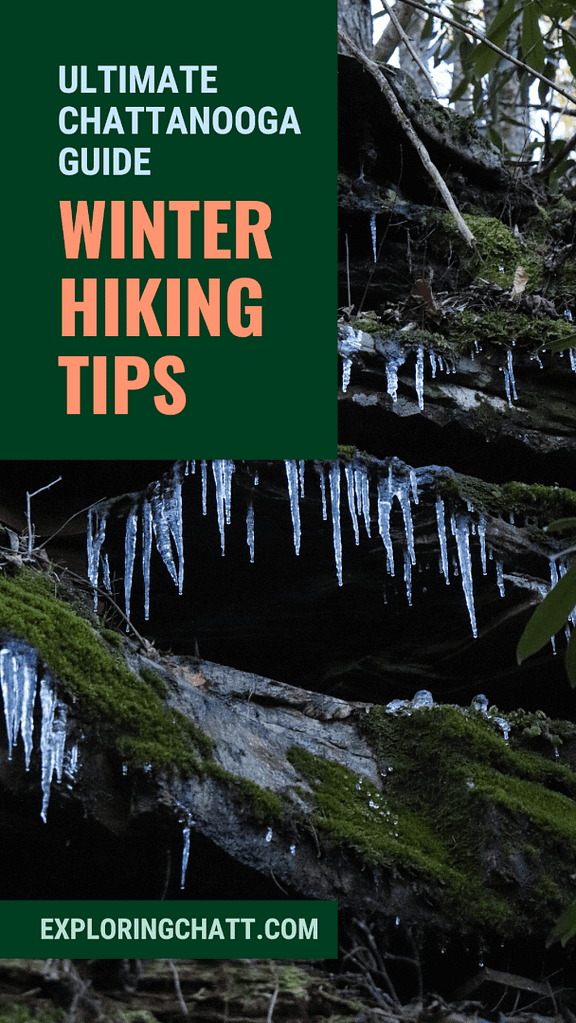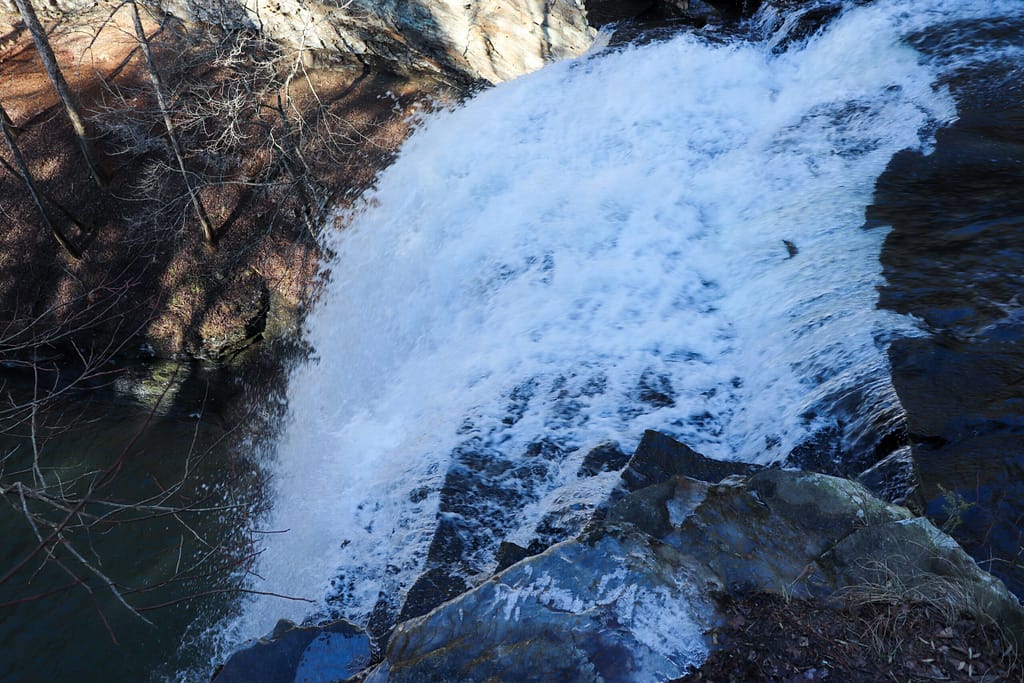Winter hiking in Chattanooga isn’t your typical freezing temps and icy snow hiking scenario, but there are still precautions that need to be taken.
When planning a winter hike in Chattanooga, there are some things to keep in mind and to watch out for. Even though snow may not be in the forecast, ice might be hiding where you least expect it. And even though it doesn’t get extremely cold around here, you might be surprised by the frigid air that you may encounter. Keep reading to learn what to potentially expect for a winter hike in Chattanooga and how to prepare and plan for the best winter hike this season.
In a hurry? Pin this post for later:


Why Chattanooga Winter Hiking is the Best
Winter is arguably one of the best seasons for hiking in the Chattanooga area. Read the sub sections below for all the reasons to choose this season for hiking over the others.
Cooler Weather and a Bug-Free Hiking Experience
Obviously, winter is the coldest season, and even though it doesn’t get down to single digits here (often), it still gets cold in Chattanooga. The humid climate of this area makes even colder temps more extreme, so don’t let the numbers fool you. If you pick a mildly cold day, it’s the perfect hiking weather for Chattanooga. Personally, anything between 50-70 degrees fahrenheit is what I would consider the best temperatures for hiking. Although some may find the colder end of that range to be too chilly while others find the warmer end to be too warm. This really is all up to personal preference. But I would not recommend hiking in much colder weather than this. Perfect temps make hiking easier because it’s less strain on your body. It’s easier to breathe and you sweat less than in the warmer months.
Because of the cold of winter and just the season itself, most bugs are non-existent. This goes for snakes as well as other forest critters that some people would rather not encounter. Winter hiking creates a more worry-free environment for those who love the outdoors minus the potential wildlife. Of course, it’s not a hundred percent creature-free, but it’s noticeably less than you’ll see in the warmer months.

Winter Hiking Views and Clear Air
Hiking views are one of the many reasons winter hiking is preferred in Chattanooga. Since most trees shed their leaves in the previous season, there’s more views visible through the tree lines. Some trails have no views at all during the summer months, but in the winter, you can make out views between the bare branches.

Another great part of winter is that the air quality is at its best. Mountain top views are typically crisp and clear in the winter. Once spring and summer roll around, these views are limited by haze from pollen and humidity. This makes Chattanooga sunrises and sunsets much more vibrant and best enjoyed in the winter months.

Chattanooga Winter Waterfalls
Winter is Chattanooga’s rainy season, especially near the end of winter entering into spring. Because of this, it’s the best time to see the waterfalls in the area. Some waterfalls don’t even flow until the rainy season because they are wet-weather falls that require lots of rainfall to stay existent.
There’s hundreds of waterfalls to choose from, so how do you narrow it down? Well, even though the waterfalls are flowing strongly at this time of year, it’s still important to choose your waterfall hike wisely. Trails tend to be wet and muddier this time of year due to excess water run-off nearby. And in some cases, icicles may form over trails adding to the slickness of the entire hike. This is why proper winter hike planning is important.



Important Tips for Planning a Chattanooga Winter Hike
The Dangers of Excess Water
The main concern with the rainy season of winter is excess water. This excess causes water run-off and in some cases turns into ice. Despite what you may think, it’s possible to encounter ice on-trail even when the temperatures are well above freezing. Sometimes the temperature drops below freezing at night causing that excess water to freeze. And some areas are shaded most of the day not allowing the sun to melt the ice. These factors create a greater potential for finding ice on your hike. And what’s more, if the waterfall and trails are on the top of mountains where the temps are even colder, the water flowing from the waterfall alone is enough to create icy spots on the nearby trail.
The most dangerous ice situation you may encounter is icicles hanging from cliffs over a hiking trail and by waterfalls. Although beautiful, take caution in these areas. Icicles will slowly melt under sunlight and in warmer weather, but often puddle on the trail and re-freeze into sheets of ice if it’s cold enough or it drops below freezing at night.



Not every trail is going to have this hazard, but we have many trails in the area that do. So plan accordingly by learning the geography of the trail you intend to hike. Does it have multiple creeks and waterfalls? Does the trail go under or directly beside a rock bluff? These factors will make the potential for icy danger higher. If the hike seems like a high probability for ice, yes, you can still hike it. Just proceed with caution and be prepared for icy trails. As always, never feel ashamed if you feel unsafe and have to turn around. Confidence in your hiking abilities is part of what keeps you safe. If you don’t feel confident in an icy situation, it’s best to turn around and come back another day when the temperature is a bit warmer. Better to be safe and well than to push yourself into a dangerous situation that could be avoided.
Also, be sure to obey the signs at the trailhead and along the trail. Some places, such as Greeter Falls, specifically state not to hike when ice is present. These rules are in place for a reason, do not disregard them.

Prepare for the Winter Weather
Remember, temperatures in the valleys can be up to 10 degrees warmer than temperatures on the mountain tops. And on top of that, the mountains shield the valleys from a lot of wind. If your hike is on top of a mountain, keep this in mind. The wind may be stronger up there and therefore feel even colder than just a 10 degree difference.

Because it’s winter, there’s minimal tree cover. If rain is in the forecast, keep this in mind. You may not want to plan a Chattanooga winter hike if it’s really cold out AND going to rain. But again, this is up to you. Everyone has different abilities and gear. If you have cold-weather and rain-proof gear, you won’t mind hiking in less than ideal winter weather. But if you don’t have these things you may want to reschedule your hike for a better weather day.
Whatever weather you decide to hike in, always keep an eye on the weather forecast in the days leading up to your hike and even the day of. Chattanooga weather has a tendency to change drastically within a short period of time. And be sure to check it for the exact area in which you plan to hike. Weather in Chattanooga can vastly differ from weather in Dayton on the same day even though they aren’t that far away from each other. Always be prepared and don’t be ashamed if you have to cancel your hiking plans last minute. It’s better to say no to a bad weather hike than to push through and be miserable, or worse, run into trouble on the hike.



Dress for a Winter Hike
Always dress appropriately for the winter weather and wear layers. As you hike, you’ll warm up and want to shed some layers of clothing. Be sure to bring a backpack that can hold all your outer layers when needed. If you need some ideas about what clothes to wear and what backpack to use, check out my hiking essentials post. After years of hiking, I’ve learned what works best to allow me to hike safely and comfortably.
Along with wearing layers, you’ll want to make sure your feet will stay warm too. Most people prefer hiking boots with wool socks for this. I, however, stick to my trailrunners. Unless it’s raining or snowy, my trailrunners are my preferred hiking shoe. But they are not waterproof or overly warm, so I would suggest a hiking boot for the occasion of rain, snow, or if you always have cold feet. I share more about these options and more in my hiking essentials post.

Short Winter Days
Another key item to note is how short winter days are. There’s still plenty of daylight to enjoy a full day of hiking. But while you’re planning your hike, look up the time for the sunrise and sunset to give you the window of availability for sunlight. A lot of trails close at sunset and only open at sunrise. You don’t want to show up too early or be stuck there too late. Plan accordingly so you’re prepared with some buffer room in case things don’t go as planned.



Chattanooga Winter Hiking Summary
Winter hiking in Chattanooga is truly one of my favorite things to do. I enjoy not sweating, lower humidity, almost no bugs, the waterfalls, the views, the list goes on. But with all good things, it’s wise to note the bad and be prepared. With these tips, you can now research where you plan to hike before you go and plan accordingly so that you know you’re prepared.
Watch this week’s video to see how I failed at judging the geography of this hike and the potential dangers it held. I have hiked this trail a few times now, but the idea never crossed my mind as to what it might look like in winter with ice. Which is why I wrote this post so you don’t make the same mistakes as me. Lesson learned, always be prepared.
I’ve also included this hike in my “A Year of Hiking” e-book under the proper season. This book is a detailed guide with maps, photos, and more for 12 hikes in the Chattanooga area. Not to mention, some good, proper winter hikes. Take a look to see if this guide would be helpful for you!
Have you found a great winter hike in the Chattanooga area? Let me know your thoughts below. Until next time, enjoy exploring Chatt!

More Ways to Safely Enjoy Chattanooga Winter:
Inspired? Pin this post for later:


